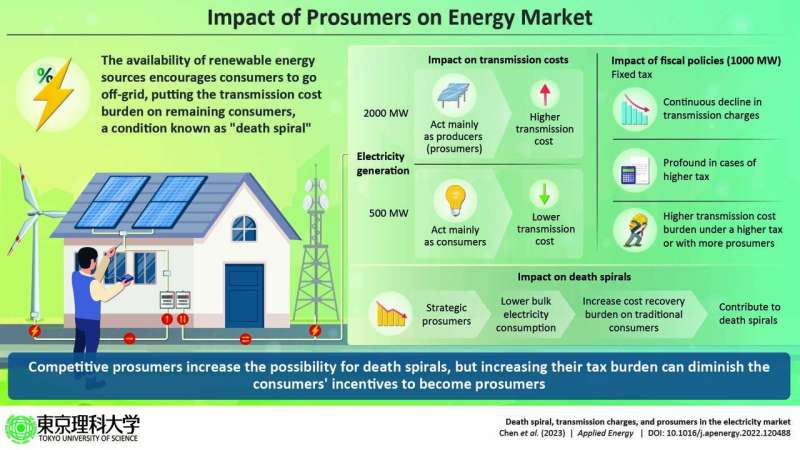

Assessing the impact of going off-grid on transmission charge and energy market...
source link: https://techxplore.com/news/2023-05-impact-off-grid-transmission-energy-outcomes.html
Go to the source link to view the article. You can view the picture content, updated content and better typesetting reading experience. If the link is broken, please click the button below to view the snapshot at that time.

Assessing the impact of going off-grid on transmission charge and energy market outcomes
by Tokyo University of Science

Efforts to combat climate change have contributed to the rise of renewable energy production through solar panels, windmills, and other technologies. Because of this, consumers have now become "prosumers," capable of producing their own electricity. While the prosumers' use of distributed renewable energy increases the energy sector's resilience, their decreased reliance on the bulk electricity market has led to new and unintended consequences.
It is anticipated that these avenues will push traditional consumers to become prosumers, making it difficult to recover lumpsum infrastructure investments and routine costs. This, in turn, will push the energy transmission charges to traditional, grid-dependent consumers.
A vicious cycle known as "death spiral" would be created, forcing the bulk energy producers to raise the transmission charge, affecting both market and consumer equilibrium. However, despite such concerns, the impact of prosumers on transmission charges and the market has not been investigated.
A team of researchers led by Professor Ryuta Takashima of the Department of Industrial and Systems Engineering at the Tokyo University of Science, Japan recently addressed this issue. Their work was published in Applied Energy .
The study involved the contributions of Professor Yihsu Chen from University of California Santa Cruz, U.S. and Professor Makoto Tanaka from the National Graduate Institute for Policy Studies (GRIPS), Japan.
The team, in their study, extended the linear complementarity model of Nash–Cournot competition developed by Benjamin F. Hobbs to simulate bilateral markets. Prof. Takashima explains, "We explicitly considered the energy transmission network and optimization of various entities in the electricity market—consumers, prosumers, producers, and independent system operators. We assumed that a prosumer, in a perfect or imperfect competition, chooses her own method of energy production and consumption."
The researchers used the PATH complementarity solver to tackle the market equilibrium problem they defined using the Karush–Kuhn–Tucker conditions from the above mentioned optimization problems.
Unlike the commonly held belief, the team found that the transmission charge does not, in fact, always increase with the number of prosumers. Rather, prosumers behave as consumers when generating less electricity (e.g., 500 MWh), which actually lowers the transmission charge. However, when prosumers generate a sizeable amount of renewable energy (e.g., 2000 MWh), the transmission charge goes up as anticipated.
The team also observed that the likelihood of death spirals increases with the presence of strategic prosumers, who lower their energy consumption from the bulk electricity market in the presence of imperfect competition. Based on these findings, the team suggested that it is possible to reduce the possibility of death spirals occurring by levying a per-MWh tax on the electricity consumption of prosumers from the bulk market.
In summary, the research provides valuable insights into the innate connection between the proportion of renewable energy sources and the quantity and behavior of prosumers, as well as their combined impact on the transmission charges.
Prof. Takashima says, "In light of the growing concern over death spirals in energy market, these findings add to the ongoing discussion about transmission costs in the presence of prosumers and shed light on death spirals. Moreover, since it is expected that such a phenomenon might occur in Japan in the future, the current research can be applied to the Japanese electricity market to offer suggestions for its aversion."
More information: Yihsu Chen et al, Death spiral, transmission charges, and prosumers in the electricity market, Applied Energy (2022). DOI: 10.1016/j.apenergy.2022.120488
Recommend
About Joyk
Aggregate valuable and interesting links.
Joyk means Joy of geeK